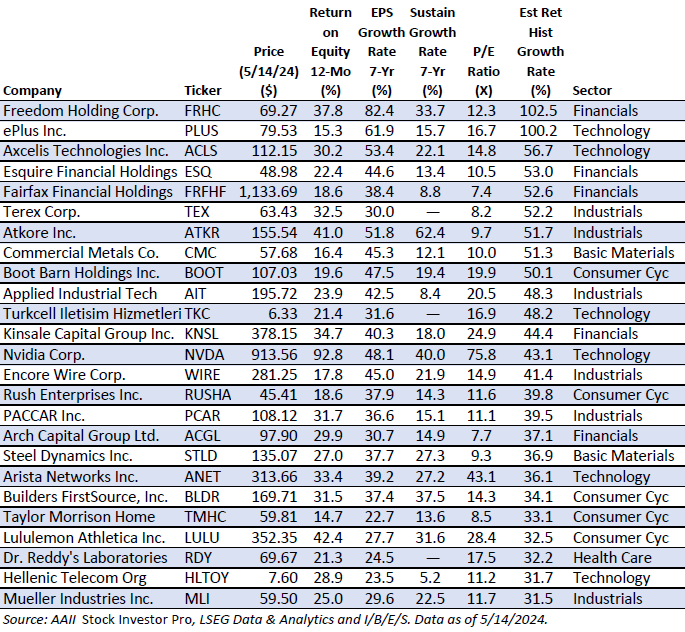Investing the Warren Buffett Way: Screening for Earnings Growth

Warren Buffett is one of the most well-known investors, earning billions through his publicly traded holding company, Berkshire Hathaway Inc. Buffett has built an impressive investing track record as well as a personal fortune.
Buffett views the underlying business as the investor’s “margin of protection.” If the business is mediocre, the stock will do poorly if purchased cheaply because the gain is limited. But if you can buy a successful company that is growing at a price that makes economic sense, you can witness your investment’s growth in value along with the business.
Buffett’s investing approach can be gleaned from his writings and explanations of holdings in the Berkshire Hathaway annual reports. Mary Buffett, Buffett’s former daughter-in-law, and David Clark, a family friend and portfolio manager, collaborated to write “Buffettology: The Previously Unexplained Techniques That Have Made Warren Buffett the World’s Most Famous Investor” (Scribner, 1999), a book that discusses Buffett’s approach in an interesting and methodical fashion.
AAII built a stock screen based on Buffett’s strategy that focuses on strong historical growth in earnings per share. On average, AAII’s Buffettology EPS Growth screen has gained 11.3% since inception in 1998, compared to the S&P 500 index’s return of 6.1%. The screen is up 6.2% year to date, versus 2.4% for the S&P 500.
Investing in a Business
Buffett believes that a successful stock investment is first and foremost a result of the underlying business. Its value to the owner comes from the company’s ability to generate earnings at an increasing rate each year. Buffett first seeks to identify an excellent business and then to acquire the firm if the price is right.
In his view, businesses can be divided into two basic types:
Commodity-based firms, which sell products in highly competitive markets in which price plays the key role in the purchase decision. Examples include oil and gas companies, the lumber industry and producers of raw food items such as corn and rice. Buffett typically avoids commodity-based firms.
Consumer monopolies, which sell products where there is no effective competitor, either due to a patent or brand name or similar intangible that makes the product or service unique.
While Buffett is considered a value investor, he typically passes up the stocks of commodity-based firms even if they can be purchased at a price below the intrinsic value of the firm. An enterprise with poor inherent economics often remains that way. The stock of a mediocre business treads water.
How do you spot a commodity-based company? Buffett looks for these characteristics:
- Low profit margins (net income divided by sales);
- Low return on equity (ROE, earnings per share divided by book value per share);
- The absence of any brand-name loyalty for its products;
- The presence of multiple producers;
- The existence of substantial excess capacity;
- Profits tend to be erratic; and
- Profitability depends on management’s ability to optimize the use of tangible assets.
Consumer monopolies are companies that have managed to create a product or service that is somehow unique and difficult to reproduce by competitors due to brand-name loyalty, a particular niche that only a limited number of companies can enter or an unregulated but legal monopoly such as a patent. The real value of these consumer monopolies is in their intangibles.
Buffett reveals three types of consumer monopolies:
- Businesses that make products that wear out fast or are used up quickly and have brand-name appeal that merchants must carry to attract customers. The best example is Coca-Cola. The product is an item that grocery stores, restaurants and other venues must carry. Other examples include drug companies with patents or even popular brand-name restaurants such as McDonald’s.
- Communications firms providing services that businesses must use to reach consumers. All businesses must advertise to reach potential customers. Today, worldwide telecommunications networks and platforms such as Google and Facebook fall into this category.
- Businesses providing consumer services that are always in demand. Most of these services require little in the way of fixed assets. Examples include tax preparers, insurance companies, lawn care services and investment firms.
The following questions can help determine the attractiveness of the business.
Is it a consumer monopoly or commodity?
Investors can find consumer monopolies by identifying the manufacturers of products that seem indispensable. Consumer monopolies typically have high profit margins because of their unique niche. AAII’s Buffettology EPS Growth screen seeks companies with operating margins and net profit margins above their industry norms. The operating margin concerns itself with the costs directly associated with production of goods and services, while the net margin takes all the company’s activities and actions into account. Follow-up examinations should include a detailed study of the firm’s position in the industry and how it might change over time.
Do you understand how it works?
As is common with successful investors, Buffett only invests in companies he can understand. Individuals should try to invest in areas where they possess some specialized knowledge and can more effectively judge a company, its industry and its competitive environment. While it is difficult to construct a quantitative filter, an investor should be able to identify areas of interest. An investor should only consider analyzing those firms passing the Buffettology EPS Growth screen that operate in areas they can clearly grasp.
Is the company conservatively financed?
Consumer monopolies tend to have strong cash flows, with little need for long-term debt. Buffett does not object to the use of debt for a good purpose — for example, if a company uses debt to finance the purchase of another consumer monopoly. However, he does object if the added debt is used in a way that will produce mediocre results — such as expanding into a commodity line of business.
AAII’s Buffettology EPS Growth approach screens for companies with conservative financing by seeking out companies with total liabilities relative to assets below the median for their respective industries. Appropriate levels of debt vary from industry to industry, so it is best to construct a relative filter against industry norms. The ratio of total liabilities to total assets is more encompassing than just looking at ratios based on long-term debt such as the debt-to-equity ratio.
Are earnings strong and do they show an upward trend?
Buffett invests only in a business whose future earnings are predictable to a high degree of certainty. Companies with predictable earnings have good business economics and produce cash that can be reinvested or paid out to shareholders. Earnings levels are critical in valuation. As earnings increase, the stock price will eventually reflect this growth.
Buffett looks for strong long-term growth as well as an indication of an upward trend. First, AAII’s Buffettology EPS Growth screen requires that a company’s seven-year earnings growth rate be higher than that of 75% of all other companies.
It is best if the earnings also show an upward trend. Buffett compares the intermediate-term growth rate to the long-term growth rate and looks for an expanding level. For the next filter, AAII requires that the three-year earnings growth rate be greater than the seven-year growth rate.
Consumer monopolies should show both strong and consistent earnings. Wild swings in earnings are characteristic of commodity businesses. An examination of year-by-year earnings should be performed as part of the valuation.
Does the company stick with what it knows?
Companies that stray too far from their base of operation often end up in trouble. Famed manager of the Fidelity Magellan fund Peter Lynch also avoided profitable companies diversifying into other areas. Lynch termed these “diworsifications.” Before investing in a company, look at the company’s past pattern of acquisitions and new directions. They should fit within the primary range of operation for the firm.
Has the company been buying back its shares?
Buffett prefers that firms reinvest their earnings within the company, provided that profitable opportunities exist. When companies have excess cash flow, Buffett favors shareholder-enhancing maneuvers such as share buybacks. Buffett views share repurchases favorably since they cause per-share earnings increases for those who don’t sell, resulting in an increase in the stock’s market price.
Have retained earnings been invested well?
Buffett examines management’s use of retained earnings, looking for management that has proven it is able to employ retained earnings in the new moneymaking ventures or for stock buybacks when they offer a greater return. A company should retain its earnings if the rate of return on its investment is higher than the investor could earn on their own. Dividends should only be paid if they would be better employed in other companies. If the earnings are properly reinvested in the company, earnings should rise over time and stock price valuation will also rise to reflect the increasing value of the business. AAII’s other screens for strong and consistent earnings and strong return on equity help to capture this factor.
Is the company’s return on equity above average?
Buffett considers it a positive sign when a company is able to earn above-average returns on equity. AAII’s Buffettology EPS Growth approach filters for companies with an average return on equity above 12%. An average return on equity for the last seven years should provide a better indication of the normal profitability for the company than just a current snapshot. However, AAII also includes a screen requiring that the current return on equity be above 12% to help assure that the past is still indicative of the company’s future direction.
Is the company free to adjust prices to inflation?
True consumer monopolies are able to adjust prices to inflation without the risk of losing significant unit sales. This factor is best applied through a qualitative examination of the companies and industries passing all the screens.
Does the company need to constantly reinvest in capital?
In Buffett’s view, the real value of consumer monopolies is in their intangibles — for instance, brand-name loyalty, regulatory licenses and patents. They do not have to rely heavily on investments in land, plants and equipment, and they often produce products that are low tech. Therefore, they tend to have large free cash flows (operating cash flow less dividends and capital expenditures) and low debt.
Is the price right?
The price you pay for a stock determines the rate of return — the higher the initial price, the lower the overall return. The lower the initial price paid, the higher the return. Buffett first picks the business and then lets the price of the stock determine when to purchase the firm. The goal is to buy an excellent business at a price that makes business sense. Valuation equates a company’s stock price to a relative benchmark. A $500 per share stock may be cheap, while a $2 per share stock may be expensive.
Historical Earnings Growth Approach
An approach Buffett uses is to project the annual compound rate of return based on historical earnings per share increases. Buffett requires a return of at least 15%. The table below lists the stocks passing the screen that have a projected rate of return of 15% or higher based on the historical earnings growth model.
25 Stocks Passing the Buffettology EPS Growth Screen (Ranked by Estimated Return Based on Historical Growth Rate)

Conclusion
Buffett’s approach identifies “excellent” businesses based on the prospects for the industry and the ability of management to exploit opportunities for the ultimate benefit of shareholders. He then waits for the share price to reach a level that would provide him with a desired long-term rate of return. The approach makes use of “folly and discipline” — the discipline of the investor to identify excellent businesses and wait for the folly of the market to buy these businesses at attractive prices.
___
The stocks meeting the criteria of the approach do not represent a “recommended” or “buy” list. It is important to perform due diligence.
If you want an edge throughout this market volatility, become an AAII member.
